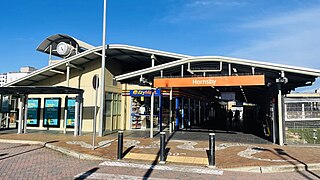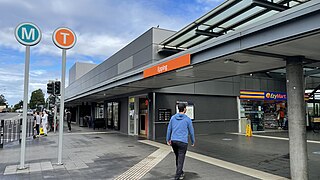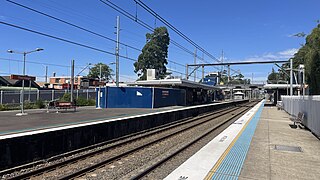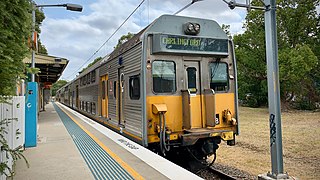
Chatswood is a railway station located in the Sydney suburb of Chatswood. It is served by Sydney Trains services; the T1 North Shore & Western Line and the T9 Northern Line, and the Sydney Metro's North West Line.

Hornsby railway station is located at the junction of the Main Northern and North Shore lines, serving the Sydney suburb of Hornsby. It is served by Sydney Trains T1 North Shore Line and T9 Northern Line services and NSW TrainLink Intercity and regional services.

Epping railway station is a railway station in Epping, in the northern region of Sydney. It is served by Sydney Trains T9 Northern Line, NSW TrainLink Central Coast & Newcastle Line, and Metro North West Line services.
Dundas is a suburb of Sydney, New South Wales, Australia. Dundas is located 21 kilometres north-west of the Sydney central business district, in the local government area of the City of Parramatta, and the electoral division of Bennelong. Dundas is a leafy green suburb, notably due to its centrepiece The Ponds Walk, which follows the Ponds Subiaco Creek. Dundas is part of the Northern Sydney and Greater Western Sydney regions.

Thornleigh railway station is located on the Main Northern line, serving the Sydney suburb of Thornleigh. It is served by Sydney Trains T9 Northern Line services.

The Northern Line is a commuter rail line operated by Sydney Trains in Sydney, New South Wales, Australia. It serves some of Sydney's Inner West and Northern suburbs. It was spun off from the old T1 North Shore, Northern & Western Line as a separate line in April 2019, to distinguish and make it more easily identified from the other T1 services. It is also a reincarnation of the older Northern Line which was under operation until 2013.

The Bankstown Line is a commuter rail line operated by Sydney Trains in Sydney, New South Wales, Australia. It serves Canterbury-Bankstown and parts of the Inner West and Western Sydney. The Bankstown railway line is the physical railway line which carries the section of the Bankstown Line between Sydenham and Birrong.

Parramatta railway station is a heritage-listed railway station located on the Main Western line, serving Parramatta in New South Wales, Australia. It is served by Sydney Trains T1 Western Line, T2 Inner West & Leppington and T5 Cumberland Line services and NSW TrainLink Blue Mountains Line, Central West XPT and Outback Xplorer services.

Sydney, the largest city in Australia, has an extensive network of passenger and freight railways. The passenger system includes an extensive suburban railway network, operated by Sydney Trains, a metro network and a light rail network. A dedicated freight network also exists. Future expansion of the light rail network includes the Parramatta Light Rail. Existing light rail services are the Inner West Light Rail and the CBD & South East Light Rail.
The Transport Construction Authority (TCA), formerly Transport Infrastructure Development Corporation (TIDC) prior to July 2010, was an agency of the Government of New South Wales that was responsible for new railway projects in the city of Sydney, Australia. On 1 November 2011 the Transport Construction Authority was subsumed into the newly-formed Transport for NSW.

Rouse Hill railway station is an elevated Sydney Metro station on Tempus Street in Rouse Hill, New South Wales, Australia. The station serves the Metro North West Line and was built as part of the Sydney Metro Northwest project.

Sydney Metro Northwest was a rapid transit project that constructed the first section of the Metro North West Line through the north-western suburbs of Sydney, New South Wales, Australia. The project included the conversion of the existing Epping to Chatswood rail link to metro standards and connects the suburbs of Rouse Hill and Chatswood via Castle Hill and Epping. The project was managed by Transport for NSW. The completed Metro North West Line opened on 26 May 2019.

Northern Sydney is a large metropolitan area in Greater Sydney, New South Wales, Australia on the north shore of Sydney Harbour and Parramatta River. The region embraces suburbs in Sydney's north-east, north and inner north west. Northern Sydney is divided into distinctive regions such as the North Shore, Northern Beaches and Forest District.

Metrobus is a high frequency, high capacity bus network in Sydney, Australia, first introduced in 2008. Metrobus services run every 10 minutes during peak periods, 15 minutes during off-peak weekday periods, and 20 minutes on weekends, linking key commercial suburbs and centres throughout the city, with the intention of making timetables obsolete. All buses were initially painted in a distinctive red livery but recently, the standard Transport for NSW livery of blue and white has been adopted. All Metrobus services are wheelchair accessible. All route numbers were prefixed with an "M" followed by a two-digit number.
Various railway lines have been proposed for Sydney, Australia, including both heavy rail extensions to the existing network, and more recently proposals for metro style lines–one of which was completed in 2019.

Sydney Trains is the operator and brand name of the train network serving the Greater Sydney metropolitan area in New South Wales, Australia. The network is a hybrid urban-suburban rail system with a central underground core that covers 369 km (229 mi) of route length over 813 km (505 mi) of track, with 170 stations on eight lines.

Sydney Metro is a fully automated rapid transit system in Sydney, New South Wales, Australia. The first component, the Metro North West Line, opened on 26 May 2019, running between Tallawong and Chatswood. It currently consists of 13 stations and 36 km (22.4 mi) of twin tracks, mostly underground. Work is progressing to extend this line from Chatswood to Bankstown as part of the City & Southwest project, which will run under Sydney Harbour and the Sydney Central Business District (CBD), with a scheduled 2025 completion. When completed, the entire line from Tallawong to Bankstown will have 66 km (41.0 mi) of twin tracks and 31 stations.

The North Shore & Western Line is a commuter rail line on the Sydney Trains network, serving the North Shore, parts of the Inner West and Western Suburbs of Sydney

The Carlingford railway line was a railway line in Sydney, New South Wales, Australia. It was opened from Clyde to Subiaco in January 1885, then by means of the construction of a bridge across the Parramatta River, to Carlingford in April 1896. It closed on 5 January 2020 with much of the line to be converted to light rail as part of the Parramatta Light Rail network, while a short section of the line was retained for use by Sydney Trains.

























